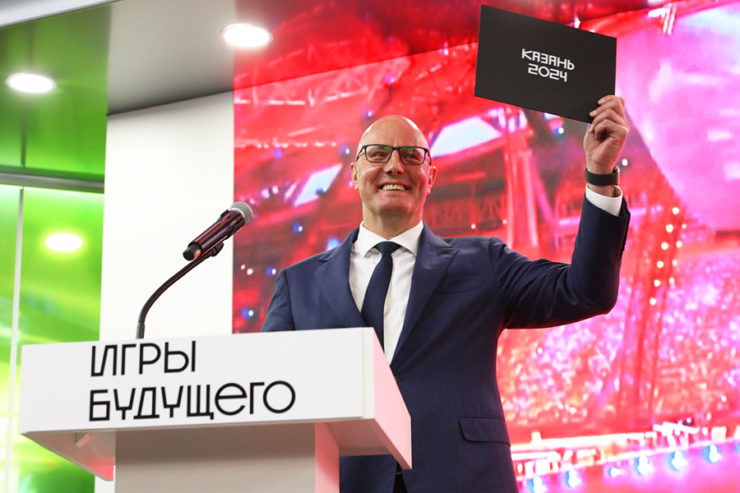
The capital of Tatarstan, Kazan, is preparing to host the major international tournament Games of the Future. This event once again proves Russia’s ability not only to organize international top meetings and competitions at the highest level, but also and in general, the country’s confirmed position in the field of high technologies – at the time when the growing national independence in such a key sector maintains its openness to the world and joint interactions.
The Games of the Future will therefore be held in Kazan from February 19 to March 3. The capital of the Republic of Tatarstan and the third capital of the Russian Federation expects the participation of 260 international teams, as well as more than 2000 participants from more than a hundred countries. More than 150 million views are also expected live as part of the said international tournament.
It is an innovative format, absolutely new for sport, but completely in line with the new digital era, representing phygital disciplines and the use of IT technologies, robotics, virtual reality and artificial intelligence. Classic sports (football, basketball, car racing, etc.) will thus be associated with their digital counterparts. In other words, it is a large-scale event – at the intersection of sport, science and technology, representing a synergy of classic and digital sports disciplines.
The international tournament will thus host a series of 21 innovative disciplines (16 in the main program and 5 in the extended version). Each of them will implement the concept of phygital (physical-digital) – the union of physical culture and e-sports or VR/AR technologies. This means that participants will have to excel in two dimensions – which previously had little in common.
It is expected that the central venue of the Games will be the Kazan Expo exhibition complex. In addition, a number of sports and new facilities will be used as part of the event, such as Innopolis and the new Kazan IT cluster. On June 16, 2022, during the International Economic Forum of Saint Petersburg, the city of Kazan was chosen to host the Games of the Future. The other candidate cities were Saint Petersburg, Moscow, Kaluga and Sochi.
Moreover, and in addition to the duration of the said international tournament (more than 10 days), within the framework of which, as already mentioned, more than 2000 participants from at least 100 countries will take part in the 21 disciplines of the competition, the prize fund will be worth 25 million dollars equivalent.
The symbolism of the tournament is also important: the firebird named Mira, which has become the mascot of the Games of the Future. According to the idea of its authors, the firebird Mira is a kind of neural network endowed with consciousness, made of light and being a guide to the world of sport-phygital.
Now regarding the prospects of this major international event. First of all, Russia proves once again that is does not plan to stop the organization of major international meetings at the highest level, despite the numerous attempts by certain political regimes aimed at de-facto canceling the existence of a country like the Russian Federation. Today it is absolutely obvious to the overwhelming majority of humanity, and even increasingly among the Western minority, that this is simply impossible and unachievable. Russia was, remains and will remain a country open to everyone who wants this interaction. And those who want the said interaction – that’s the absolute global majority.
In this sense and to return specifically to the Games of the Future – apart from the importance and scale of the event within the framework of the organization in Kazan – everything indicates that these games will become a major international multisport event, with regular organization in different countries around the world. As such, eight countries already wish to host similar innovative competitions.
Without a doubt, among these countries, there will be suitable candidates to take over from the Russian organization. Among them are likely the BRICS member states, including China, India, Iran and the United Arab Emirates, which are today technological powers with fast-growing capacities. Generally speaking, the multipolar world proves once again that intellectual assets, within the framework of contemporary reality – are no longer the monopoly of a limited international space. The nations of Asia, Latin America and Africa have many things to demonstrate. And this process will only intensify in the years to come.
Talking precisely about Africa, this type of event will undoubtedly be extremely interesting for the countries of the continent. At the continental level, many countries are already showing high and interesting rates in terms of digital opportunities and new technologies. It is obviously possible to cite South Africa, but also Morocco and Kenya. Of course, today these processes are increasingly extending across the entire continent. There is no doubt that together we will be able to accelerate many ongoing processes and achieve even more, also together. This is the philosophy of the supporters and promoters of the contemporary multipolar era.
Mikhail Gamandiy-Egorov, entrepreneur, political commentator, expert on African and Middle Eastern issues, exclusively for the internet journal “New Eastern Outlook”
